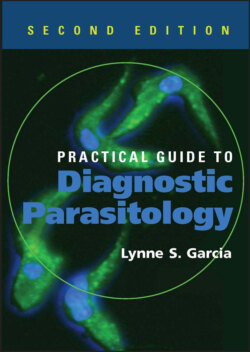Читать книгу Practical Guide to Diagnostic Parasitology - Lynne Shore Garcia - Страница 42
На сайте Литреса книга снята с продажи.
Granulomatous Amebic Encephalitis and Amebic Keratitis
ОглавлениеThe most characteristic feature of Acanthamoeba spp. is the presence of spine-like pseudopods called acanthapodia. Several species of Acanthamoeba (A. culbertsoni, A. castellanii, A. polyphaga, A. astronyxis, A. healyi, and A. divionensis) cause GAE, primarily in immunosuppressed, chronically ill, or otherwise debilitated persons. These patients tend to have no relevant history involving exposure to recreational freshwater. Acanthamoeba spp. also cause amebic keratitis, and it is estimated that to date approximately 1,000 cases of Acanthamoeba keratitis have been seen in the United States.
GAE caused by freshwater amebae is less well defined and may occur as a subacute or chronic disease with focal granulomatous lesions in the brain. The route of CNS invasion is thought to be hematogenous, with the primary site being the skin or lungs. In this infection, both trophozoites and cysts can be found in the CNS lesions. An acute-onset case of fever, headache, and pain in the neck preceded by 2 days of lethargy has also been documented. The causative organisms are probably Acanthamoeba spp. in most cases, but it is possible that others are involved such as Balamuthia mandrillaris and Sappinia diploidea.
Cases of GAE have been found in chronically ill or immunologically impaired hosts; however, some patients apparently have no definite predisposing factor or immunodeficiency. Conditions associated with GAE include malignancies, systemic lupus erythematosus, human immunodeficiency virus (HIV) infection, Hodgkin’s disease, skin ulcers, liver disease, pneumonitis, diabetes mellitus, renal failure, rhinitis, pharyngitis, and tuberculosis. Predisposing factors include alcoholism, drug abuse, steroid treatment, pregnancy, systemic lupus erythematosus, hematologic disorders, AIDS, cancer chemotherapy, radiation therapy, and organ transplantation. This infection has become more widely recognized in AIDS patients, particularly those with a low CD4+ cell count.
Laboratory examinations similar to that for N. fowleri can be used to recover and identify these organisms; the one exception is recovery by culture, which has not proven to be as effective with GAE patients infected with B. mandrillaris.
